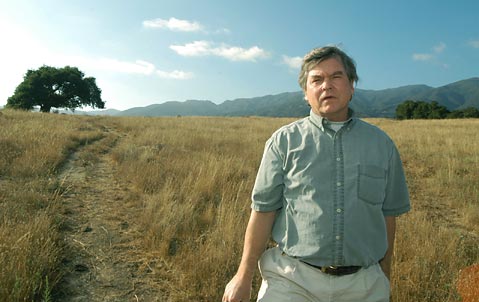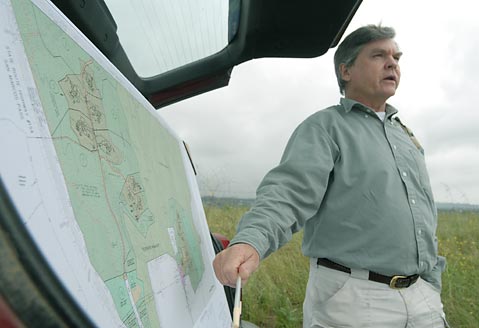Weeding and Waiting at the San Marcos Foothills
Restoration Projects Are Underway But Development Is Not on Coveted Property

A decade ago, biologist Mark Holmgren took a young reporter out to the San Marcos Foothills, where he summoned rare birds with his expert calls, pointed out hard-to-find native plants, outlined the importance of boulder fields, and otherwise presented evidence as to why this 377-acre chunk of land near the intersection of Highway 154 and Foothill Road was worth saving from overdevelopment. In 2007, Holmgren’s advocacy — and that of the San Marcos Foothills Coalition (SMFC), whose members had fended off massive housing schemes for decades — finally paid off: Instead of the hundreds of homes that were once proposed, the County of Santa Barbara approved a deal between the coalition and developer Jeff Bermant that called for the construction of 15 market-rate single-family homes and an affordable four-plex in exchange for more than 200 acres of public land and 100 acres of private open space.
Last week, Holmgren — now retired from his UCSB post, his hair slightly grayer and much longer, but still sporting the floppy outdoorsman hat, cutting-edge binoculars, and those expert bird calls (although he now also plays some from his iPod over a portable speaker) — accompanied this same, albeit balder, reporter back to the foothills for another walk around. But rather than grinning upon seeing the land he helped saved — a smile that should have been even broader, given the recession-related stalling of the approved development — Holmgren proved somewhat grim. “In the early 2000s, the richness of flora and fauna was unbelievable in the San Marcos Foothills,” said Holmgren. “We’ve lost some of that … The most devastating thing that has happened is all the weeds.”
Part of the development/preservation deal was the removal of cattle that had grazed on the property for more than a century, said Holmgren, explaining that the cows had managed to suppress the nonnative plant species like mustard, thistle, fennel, hemlock, castor bean, and radish and allowed the natives, such as western ragweed, datura, giant rye, chamise, and wild rose, to thrive. Without the cows, the weeds have exploded throughout the property, “suffocated” the natives, and thwarted the natural habitat for critters of all sizes, which is what Holmgren had predicted. “People don’t listen to their local biologist, man,” snickered Holmgren. “That’s the biggest problem.”
So with funding from the SMFC and the Goleta Valley Land Trust, Holmgren, attorney Tom Stone, and the team from Channel Islands Restoration are embarking on an effort to attack the weeds in two publicly accessible sites: “the corral” on Atascadero Creek and “the spring” along Cieneguitas Creek. Both are about two acres, both will end up costing about $50,000, and both will involve the use of mulch to suppress the exotic species while enhancing the existing natives. Though just a fraction of the entire landscape, Holmgren and company have big dreams about future work, perhaps improving the entire spring area, allowing the surrounding floodplains to actually flood during storms, and even working on the difficult tasks of stream and chaparral restoration. “We want to put the San Marcos Foothills on the restoration map,” said Holmgren, explaining that they will “rely heavily” on volunteers and hoping that “the neighbors will take over and assure long-term stewardship of this land.”

County Contributions
While the restoration crews focus on four acres of invasive shrubbery, the County of Santa Barbara’s budget-strapped Parks Department is left to deal with the rest of the 210-plus acres of publicly accessible open space. “We’re kind of an understaffed agency at this point, so it’s a little tough,” admitted Deputy Director Erik Axelson, though he said that a series of stakeholder meetings held over the past two years to draft a long-range management plan had been “reasonably successful.” The plan, however, is taking longer than expected, but should be out in the fall.
In a dream budget, Axelson said that the county would be doing weed abatement, trail construction and maintenance, fire prevention work, interpretive programs, and much more. But since such funding is nowhere in sight, the Parks Department is welcoming the sort of public-private partnerships that are reflected in Holmgren’s restoration plans. The recent completion of a trail from the end of Antone Road to the Via Gaitero parking lot is another example, in this case with Ray Ford and the Santa Barbara Trails Council taking the lead as the county provided logistical support when possible. “We thought it was important to provide an east-west link across the property, which this new trail does quite well,” said Axelson, whose team also installed signage at the Via Gaitero entrance and will soon be putting up some fencing to separate the county land from the private, to-be-built parcels. Also on Axelson’s wish list is hiring docents to lead natural history walks, collaborating with schools and summer camps to bring children to the property, and perhaps a return of some careful grazing courtesy of goats.
But even with unlimited funding, the San Marcos Foothills will remain a challenge for the Parks Department, because its mission is two-fold: serve the public but save the landscape. Explained Axelson, “We have to find the right balance between offering access but not in such a way that it overwhelms the natural features or does harm to the heritage of the preserve.”
Development Delayed
Of all the developments at the San Marcos Foothills, the biggest curiosity is the lack of any actual development, three years following county approval. That’s been cause for celebration to many in the anti-development crowd and has given rise to rampant speculation on whether the 15 homes and affordable four-plex will ever actually appear. But according to the developers — namely Jeff Bermant, who spearheaded the 2007 deal after years of negotiations with preservationists, and Michael Evanisko of Specialty Restaurants Corporation, the company that owns the land and is now running the day-to-day show — only the recession is to blame.
“The absolute truth is that no banks will lend you a dollar for anything. And the market won’t buy anything either,” said Bermant, who explained that the Bermant Development Company is “fine” although he is shifting his professional focus to anti-virus security technology on the Internet. “The world is at an absolute standstill for development.”
Nonetheless, Evanisko explained that the partnership is “well capitalized and is in a position to wait for the market to normalize”; that “The Meadows” home sites are ready for sale and being marketed through on-site signage, as well as at sbmeadows.com; that architect Barry Berkus is involved in custom home design; and that they are “looking forward to adding to the much-needed affordable housing stock,” with construction of the four-plex likely to begin by the end of the year after working out an easement with the electrical company for nearby power lines.
Furthermore, the developers have already installed much of the required infrastructure for the home sites and have also completed some of the required mitigation work for the expected habitat disruption caused by the future homes. While most of the natives planted were destroyed by the Jesusita Fire — the county is waiting to see whether they come back before deciding whether more work is required — the improvements are evidence enough to the county that the project will go forward. “They have put in all the infrastructure for The Meadows, which is a substantial outlay of wealth,” said Anne Almy of the Planning and Development Department. “That gives them entitlement to continue to build out. Their permit is alive and active.”



